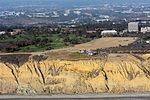Farmers Insurance Open
The Farmers Insurance Open is a professional golf tournament on the PGA Tour, played in the San Diego, California, area in the early part of the season known as the "West Coast Swing". The tournament was noted for having singer-actor Andy Williams as a celebrity host from 1968 through 1988. It originated as the San Diego Open in 1952 and used that name in its title through 1985. Title sponsors were added in 1981, first with Wickes for two years, then three with Isuzu. Shearson Lehman Brothers became the title sponsors in 1986, replaced by Buick in 1992 and Farmers Insurance in 2010. The event is organized by The Century Club of San Diego. Although the San Diego Open began in 1952, the PGA Tour recognizes two earlier events of the same name: Leo Diegel won both events, in December 1927 and January 1929. It was an autumn event in 1956 and 1957, not held in 1958, and returned as a winter event in early 1959.
Excerpt from the Wikipedia article Farmers Insurance Open (License: CC BY-SA 3.0, Authors).Farmers Insurance Open
North Torrey Pines Road, San Diego Torrey Pines
Geographical coordinates (GPS) Address Nearby Places Show on map
Geographical coordinates (GPS)
| Latitude | Longitude |
|---|---|
| N 32.903 ° | E -117.245 ° |
Address
The Lodge at Torrey Pines
North Torrey Pines Road 11480
92037 San Diego, Torrey Pines
California, United States
Open on Google Maps






